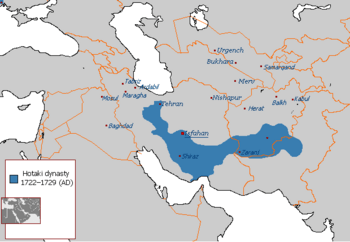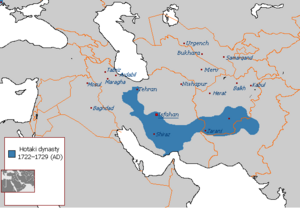Hotaki dynasty facts for kids
Quick facts for kids
Hotak Empire
|
|||||||||||
|---|---|---|---|---|---|---|---|---|---|---|---|
| 1709–1738 | |||||||||||

Hotak Empire at its peak (1722–1729)
|
|||||||||||
| Capital | Kandahar Isfahan |
||||||||||
| Common languages | Pashto and Persian (poetry) | ||||||||||
| Religion | Sunni Islam | ||||||||||
| Government | Absolute monarchy | ||||||||||
| Emir | |||||||||||
|
• 1709–1715
|
Mirwais Hotak | ||||||||||
|
• 1715–1717
|
Abdul Aziz Hotak | ||||||||||
|
• 1717–1725
|
Mahmud Hotak | ||||||||||
| Historical era | Early modern period | ||||||||||
|
• Revolt by Mirwais Hotak
|
21 April 1709 | ||||||||||
| 24 March 1738 | |||||||||||
|
|||||||||||
The Hotak Empire was a powerful kingdom that existed in the early 1700s. It was founded in 1709 by a leader named Mirwais Hotak in a city called Kandahar, which is in modern-day Afghanistan. The people who started this empire were Pashtuns, an ethnic group from the Hotak tribe.
The Hotaks first fought for their freedom from foreign rulers. After gaining independence, they expanded their territory. They even managed to conquer the large Persian Empire, which was ruled by the Safavid dynasty at the time.
Contents
Rise of the Hotak Empire
Mirwais Hotak: The Founder
Mirwais Hotak was a respected leader of the Ghilji Pashtun tribe. He lived in Kandahar, which was then part of the Safavid Persian Empire. The Safavid rulers were not popular with the local people. They often treated the Pashtuns unfairly.
Mirwais Hotak decided to lead a revolt against the Safavid governor. In 1709, he successfully drove out the Safavid forces. This victory made Kandahar independent. This moment marked the beginning of the Hotak dynasty. Mirwais Hotak ruled as the first leader, or Emir, until his death in 1715.
Expansion Under Mahmud Hotak
After Mirwais Hotak passed away, his son Mahmud Hotak became the new leader in 1717. Mahmud was very ambitious. He wanted to expand the Hotak Empire beyond Kandahar. He led his army into Persia, the heartland of the Safavid Empire.
In 1722, Mahmud Hotak achieved a huge victory. He defeated the Safavid army and captured their capital city, Isfahan. This was a major event because it meant the Hotak Empire now controlled a large part of Persia. Mahmud Hotak then became the ruler of Persia.
Challenges and Decline
Ashraf Hotak's Reign
Mahmud Hotak ruled Persia until he died in 1725. After his death, his cousin Ashraf took over as the ruler. Ashraf Hotak was a strong leader. He tried to keep the empire together. However, the Hotak Empire faced many challenges.
The Persian people were not happy with foreign rule. Also, other powerful groups in the region started to challenge the Hotaks. One of these groups was led by a brilliant military commander named Nader Shah.
The Fall of the Empire
Nader Shah was a general who wanted to restore Persian rule. He began to fight against the Hotaks. In 1729, Nader Shah's forces defeated Ashraf Hotak. This loss meant the Hotaks lost control of Persia. Ashraf Hotak was forced to flee.
The Hotak Empire then shrunk back to its original base in Kandahar. The last Hotak ruler was Hussain Hotak. He continued to rule in Kandahar for several more years. However, Nader Shah was determined to completely end the Hotak dynasty.
In 1738, Nader Shah launched a siege on Kandahar. After a long and difficult fight, Kandahar fell to Nader Shah's forces. This defeat marked the final end of the Hotak Empire. The empire had lasted for about 29 years.
Legacy
The Hotak Empire was a significant part of Afghan history. It showed the strength and independence of the Pashtun people. Even though it was a short-lived empire, it played a key role in shaping the region's future. It also weakened the Safavid Empire, which led to new powers rising in Persia.
See also
 In Spanish: Dinastía hotaki para niños
In Spanish: Dinastía hotaki para niños
- Mirwais Hotak
- Mahmud Hotak
- Ashraf Hotak
- Hussain Hotak



